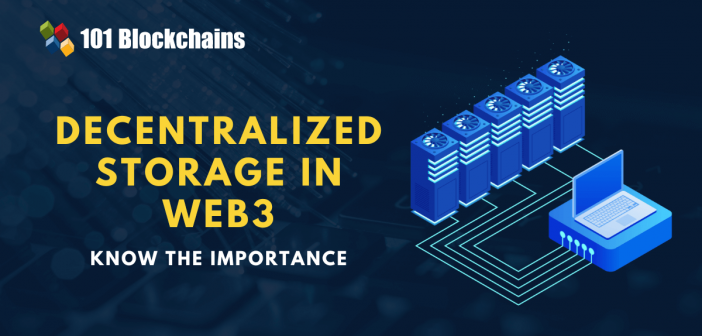Learn how blockchain truly works, master key definitions, and uncover what makes smart contracts so "smart." Dive into the fundamentals, gain valuable insights, and start your blockchain journey today!

Web3
James Howell
on June 23, 2023
The Importance of Decentralized Storage in Web3
The most promising value proposition associated with web3 refers to the advantage of ownership over users’ data. Market research reports have predicted that the global web3 market could reach the size of almost $23 billion by 2028. On top of it, web3 has also captured the interest of many venture capitalists and investment firms, seeking a decentralized storage system. As a matter of fact, web3 emerged as one of the most valuable investment deals in 2022.
At the same time, the growth of web3 has also prompted the rise of web3 decentralized storage solutions that can help in ensuring secure archival, retrieval and maintenance of their data. Growing volumes of data storage across the globe can lead to increasing costs of security. Therefore, web3 needs decentralized storage solutions with the help of blockchain technology. The following post helps you learn about the significance of decentralized storage in web3.
Meaning of Decentralized Storage
One of the first things you would need to learn about decentralized storage in web3 would refer to its definition. The basic understanding of the decentralized storage system in web3 showcases that the storage system would not depend on a centralized authority. Centralized storage systems such as cloud service providers have been the foundations for the existing technological landscape.
Websites, applications, networks and systems rely on extensive storage mechanisms, such as data centers, spanning multiple geographical locations. However, the problem with centralized data storage mechanisms is the lack of security. Centralization creates a single point of failure, which is the most prominent vulnerability for storage mechanisms.
The answers to “What does decentralized mean in web3?” would help in understanding how decentralization can remove the single point of failure. Decentralization of storage implies that the storage is managed by a peer-to-peer network with nodes operated by users. Each node in the peer-to-peer network stores a copy of data, thereby developing a highly resilient file storage and sharing system. As a result, it can ensure better resistance to censorship alongside attacks in comparison to traditional storage systems.
Significance of Decentralization in Storage
New changes in infrastructure with the arrival of web3 would emerge as prominent highlights in the tech landscape. What are the popular solutions for hosting websites and files? The answers would lead you to AWS, Google Drive or Dropbox. Why do you need a web3 storage alternative to these popular choices? Individuals, large companies as well as startups have leveraged the benefits of centralized storage services.
However, concerns about censorship and information integrity alongside vulnerabilities to attack establish the demand for better alternatives. Decentralized storage offers a viable solution by delivering secure, efficient, distributed and censorship-resistant data storage with the advantages of cost-effectiveness.
Build your fluency in Web3 and develop decentralized solutions with the world’s first Web3 Expert Career Path with quality resources tailored by industry experts Now!
How Does Decentralization Work in Web3?
The introduction to web3 file storage must showcase the advantages of decentralized storage and how it works. Each node in a peer-to-peer network of nodes can play a crucial role in the distribution of copies or portions of the complete data. The nodes in the peer-to-peer network receive incentives for data storage, and a decentralized storage system ensures the benefit of redundancy throughout various nodes. As a result, decentralization can ensure promising improvements in accessibility and security. Imagine having copies of the same file across different nodes in a network. Users can still retrieve the data from other storage nodes even if a few nodes are down.
The node operators receive rewards for renting out their unused storage space to decentralized storage networks. A review of web3 data storage basics would also refer to the simple steps in its working. The first step in the working of a decentralized storage system begins with the user uploading the file. In the next step, the file has to be encrypted. Subsequently, the encrypted file has to be divided into different pieces, which go to different storage nodes in the decentralized storage network.
Blockchain-based decentralized storage involves every node in the blockchain network storing a copy of the data. Blockchain is responsible for ensuring data availability alongside resolving the problems of data integrity. In addition, web3 decentralized storage networks can leverage blockchain to deliver a transparent and secure approach to tracing data ownership alongside facilitating data integrity. Every block in the blockchain includes a cryptographic hash for the previous block, which creates a chain of blocks that you cannot delete or modify. The transactions which can add or change data must go through verification and must be validated by all network participants.
Prominent Traits of Decentralized Storage
The fundamentals of decentralization in storage provide a clear impression of how decentralized storage will be the norm for web3. Another important aspect in answers to “What does decentralized mean in web3?” would point to how everything in web3 would be decentralized. Decentralization is a primary objective of web3, and storage systems must have the following traits to address the demands of storage.
- Distributed architecture is a vital aspect of decentralized storage and ensures data storage across different nodes in a network. It is a prominent highlight in the reduction of the risks for data loss alongside increasing the reliability of architecture.
- Decentralized control ensures that the storage system does not have a single point of control, thereby increasing censorship resistance and safeguards against data breaches.
- The next crucial aspect of a decentralized storage system focuses on peer-to-peer communication. It ensures direct data transfer among nodes and removes central authorities from data management responsibilities.
- Data encryption and hashing mechanisms can help in ensuring integrity and privacy for information stored in decentralized storage systems.
Decentralized storage also guarantees the value benefits of dynamic data management, depending on the factors of node availability, network conditions and load specifications. On top of it, monetary incentives for storage node operators serve as valuable highlights for encouraging security in decentralized storage.
Advantages and Setbacks of Web3 Decentralized Storage
The review of the implications regarding the value of decentralized storage must also include references to its advantages and setbacks. The benefits of web3 file storage have garnered prominent levels of attention in recent times. Decentralized storage offers a broad set of advantages. However, it is important to learn about the impact of decentralized storage on web3. Here are the promising advantages of decentralized storage for the web3 landscape.

-
Cost-efficiency
Decentralized storage offers the freedom from massive upfront capital investments in data centers. As a result, it can provide cost-efficient alternatives to centralized storage solutions. The web3 storage alternative has promising potential as many users have expressed their will to rent unused disk space. Cost-efficiency benefits of decentralized storage can deliver a competitive advantage to different businesses.
-
Enhanced Security
The most favorable advantage of the web3 storage system is security. Decentralized storage breaks down files and distributes them across different nodes. Therefore, vulnerabilities in one node could not affect the rest of the nodes. Blockchain can deliver promising value improvements to security for web3 data storage with granular access controls and trustless architecture. The characteristic trait of decentralized storage in its design ensures freedom from a single point of failure, thereby guaranteeing better security. On top of it, encryption mechanisms for decentralized storage solutions guarantee the safety of personal information.
-
Better Reliability and Scalability
Decentralized cloud storage can help in ensuring limited downtime through the distribution of data throughout different nodes. Even in the event of failure of a particular server, users can retrieve their data from other nodes. In addition, a decentralized storage system can scale up according to the emerging requirements of web3 solutions. For example, DeFi apps would experience radical growth in the number of users and transaction volume. Therefore, the growing need for decentralized data storage in web3 use cases can leverage the benefits of scalability.
The list of advantages of decentralized storage serves as a clear impression of how it can support the growth of web3. On the other hand, decentralized storage in web3 also presents certain risks. For example, some critics have pointed out that web3 file storage is a complex process, and you need technical expertise to build decentralized storage systems. The ability to rely on a centralized and dependable storage partner with centralized service providers has some accountability. Therefore, decentralized storage systems end up with a few setbacks for users and businesses.
Get familiar with the terms related to Web 3.0 with Web 3.0 Flashcards
Decentralized Storage Solutions in Web3
The most noticeable part of an introduction to decentralized storage in web3 refers to the examples of decentralized storage platforms and protocols. You can find one of the basic examples of web3 decentralized storage in Ethereum. However, Ethereum is a smart contract blockchain and is useful for storing code only. On the contrary, web3 adoption would require capabilities for storing massive volumes of data. Therefore, the following solutions could have a vital role in the expansion of decentralized storage in web3.
-
IPFS
Interplanetary File System, or IPFS, is one of the most intriguing names. It almost alludes to Captain Buzz Lightyear or some Star Wars stories from a certain perspective. However, it is one of the most popular protocols for decentralized file storage, and everyone in the web3 landscape needs IPFS. You are less likely to find a guide on web3 storage alternative solutions without the example of IPFS. Interplanetary File System serves as a peer-to-peer protocol that enables the storage, access and sharing of data across a distributed file system.
What is the special advantage of IPFS, and how does it matter to web3? You can find the answer in an overview of a popular problem existing on the internet. The common approach for the working of IPFS refers to the methods for accessing files from decentralized file storage.
Type in the website name, and you can find the content in web2 websites. However, what if the website changes the location of the content? In such cases, you would need content identifiers for content addressing. The CID for every content ensures that they are associated with the cryptographic hash of the data, which points to data in IPFS storage.
Therefore, two similar files are more likely to have similar CID, and a small difference in the content could generate a completely different content identifier. IPFS also leverages the advantages of the SHA256 hashing algorithm for generating content identifiers. It offers the advantages of content addressing in decentralized storage for efficient identification and retrieval of content.
Want to become a Cryptocurrency expert? Enroll Now in Cryptocurrency Fundamentals Course
-
Swarm
Examples of web3 file storage alternatives would also include Swarm. It is a decentralized protocol that has been tailored as a crucial aspect of the Ethereum ecosystem. Swarm delivers a completely resilient decentralized storage mechanism that helps people worldwide offer their storage on rent and obtain payments. It has been developed to offer higher scalability and resiliency alongside providing platforms for applications that need higher security and resistance against censorship.
Swarm has many differences in comparison to IPFS, such as the core storage component, which utilizes an immutable content-addressed block store. On the other hand, IPFS leverages distributed hash tables which can help in identifying the peers responsible for hosting the content. The integration of Swarm with the Ethereum ecosystem ensures lucrative prospects for incentives.
-
Filecoin
Another popular entry among decentralized storage system examples is Filecoin, which has been created over IPFS. It has been created by the developers of IPFS, and Filecoin features a native token, FIL, which they can receive as a reward for unutilized storage space. With the help of Filecoin, users can pay for storage space, and any individual interested in storing the files of users could receive monetary incentives.
Excited to develop a comprehensive understanding of Polygon web3 development? Enroll Now in Polygon Web3 Development Course!
Final Words
The significance of decentralization in web3 is evident in how the uses of technology are changing. At this point in time, almost over a century ago, technical advancements such as electrical appliances and automobiles changed the face of society. The discussion about the web3 decentralized storage relationship is a vital requirement for web3 professionals interested in building new projects. Decentralized storage provides the solutions for the most critical pain points in the adoption of web3.
For example, blockchain can facilitate better data security advantages in decentralized storage. Learn more about blockchain, web3 and their interplay to build a successful career in web3. Search for the best resources to learn about web3 applications, benefits, challenges and their association with Ethereum, NFTs and blockchain.
Begin your journey as a trained and certified web3 professional with the experts now!
*Disclaimer: The article should not be taken as, and is not intended to provide any investment advice. Claims made in this article do not constitute investment advice and should not be taken as such. 101 Blockchains shall not be responsible for any loss sustained by any person who relies on this article. Do your own research!







